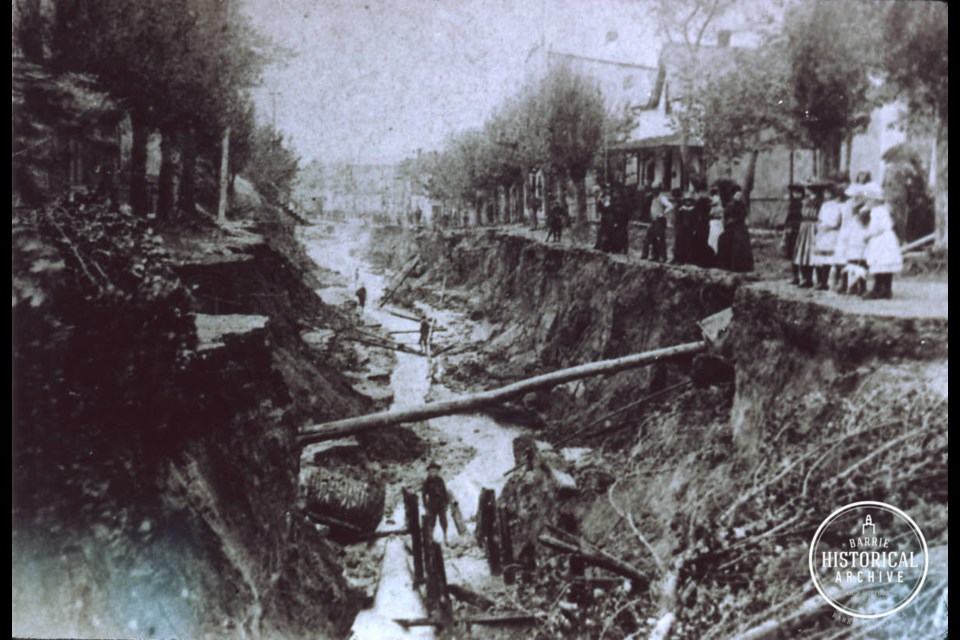When the last ice age carved its way through our part of the world, it dug especially deep into the limestone at the west end of Lake Simcoe and created Kempenfelt Bay as well as the sizeable hills on either side of it.
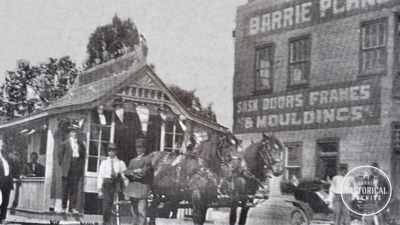 A creek runs below the warehouse of Ball Planing Mill, now Parry Automotive, on Sophia St. Photo courtesy of Barrie Historical Archive.
A creek runs below the warehouse of Ball Planing Mill, now Parry Automotive, on Sophia St. Photo courtesy of Barrie Historical Archive.The water in the bay is some 100 feet deep in places, while the hills can rise to 200 feet up from the shore. From the ridges, fantastic views are to be had, and quite a number of grand houses were built along these heights to take advantage of the beautiful vistas.
In the early years, Barrie's centre of commerce, naturally sprang up along the shoreline to be near roads and waterways and eventually rail transportation. Working folks and businesspeople were more likely to make their homes in the neighbourhoods in and around the area we call downtown today.
Nature does not care if you are rich or poor, but it certainly does discriminate against those who live and work in low lying areas when it comes to disposing of excess rain water.
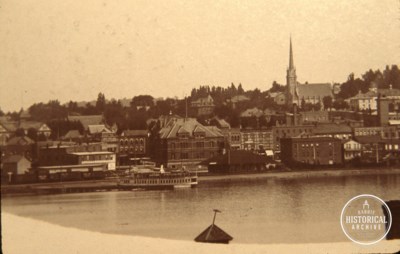 Barrie as it looked around 1900. Photo courtesy of Barrie Historical Archive.
Barrie as it looked around 1900. Photo courtesy of Barrie Historical Archive.The residents of Barrie were accustomed to the occasional wild thunderstorm of summer. On a hot day, black clouds would burst open and send townsfolk running for shelter under a shopkeeper’s awning. After the flashing and banging had subsided, and the rainfall lessened, boots and skirts got muddied as the shoppers waded through ankle deep puddles on the way home again. This was not unusual.
What happened on June 5, 1890 was quite different.
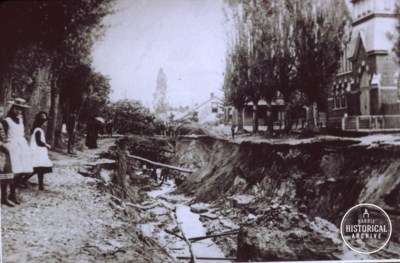 The devastation of the flood near the Baptist Church. Photo courtesy of Barrie Historical Archive.
The devastation of the flood near the Baptist Church. Photo courtesy of Barrie Historical Archive.That Thursday followed three days of slightly higher than average rain fall, which had saturated the ground, but there was another problem. The town had several streams running through it, all headed to the bay, with some having culverts maintained by the town and others passing through private property. It was a mish-mash of poorly built, often wooden, culverts and brush-filled creeks which sometimes overflowed their banks on particularly rainy days. Ironically, a large contributing factor to the disaster of that June day was an effort by the municipality to finally deal with the flooding issue.
The Northern Gazette of June 12, 1890, quoted some townsfolk who had observed a storm approaching from the northwest, while another one seemed to be coming from the east. “Sometimes the wind blew from the north-west and then it would suddenly change to the north-east, the two storm clouds meeting a little to the north of town, seemed to neutralize each other’s motion, and then the rain, which was in sheets of water, rather than drops, came from one point and then from another, and again straight down.”
From this description, I would say that Barrie very nearly experienced a devastating tornado.
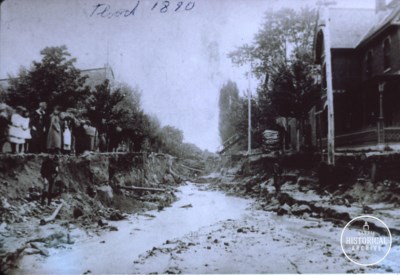 Terrible damage to Clapperton St. north of Five Points. Photo courtesy of Barrie Historical Archive.
Terrible damage to Clapperton St. north of Five Points. Photo courtesy of Barrie Historical Archive.Earlier in the day, on June 5, workmen had succeeded in tearing out all of the old pipes and broken culverts from the main town drainage system along Clapperton St. just above Five points. At 2:00 in the afternoon, the rain began and the labourers left their work to wait for the storm to pass, but it refused to do so. Northeast of the Clapperton St. work site, a large puddle began to form behind a low ridge on Peel St. near Wellington St., which then grew into a pond which was possibly 3 acres in size and 6 feet deep before it jumped the ridge and began racing downtown. That was at 2:15 p.m. By 3:00 p.m., the rain was still falling in buckets and all the other creeks, including ones near Sophia St., Bayfield St. and Sanford St. had all overflowed their banks.
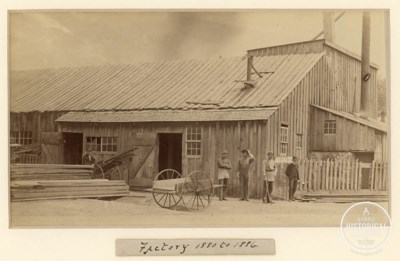 The Ball Planing Mill, which stood at 76 Bayfield St. Photo courtesy of Barrie Historical Archive.
The Ball Planing Mill, which stood at 76 Bayfield St. Photo courtesy of Barrie Historical Archive.The water began raging down all the north-south running streets including Bayfield, Owen and Mulcaster, dragging timbers, bushes, sand and gravel, garbage and all manner of debris with it, while saving its harshest treatment for the already excavated channel running down Clapperton St. As it said in that same edition of the Northern Gazette: “Clapperton Street was a grand and wonderful scene. It had the appearance of a great river, as it rushed past the Five Points.”
Cellars filled with dirty water. Gardens were washed away. The railway tracks were undermined and rail cars sank down a number of feet. The swampy area at the head of the bay appeared to have been converted into a beach after tons of sand were deposited there. The playground at the Central School in Barrie became a lake and the children had to be carried out.
The tremendous rain reached its worst at 4:00 p.m., after two solid hours of deluge, and then quit. At 5:00 p.m., Dunlop St. was still a fast running river and all the creeks were continuing to overflow.
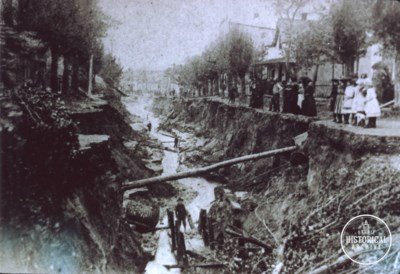 Looking down Clapperton St., from about Worsley St., to Five Points, after the flood. Photo courtesy of Barrie Historical Archive.
Looking down Clapperton St., from about Worsley St., to Five Points, after the flood. Photo courtesy of Barrie Historical Archive.When all was said and done, there was terrible mess left behind that would take weeks to rectify. Clapperton St. looked the worst, having been eroded from sidewalk to sidewalk between Worsley St. and Five Points, with a chasm cut nearly 20 feet deep in spots. Large trees lay in the trench and the Baptist church on the corner had its foundation laid bare. There was concern that it might not be stable any longer, but the church building still stands today, nearly 127 years later.
Each week, the Barrie Historical Archive provides BarrieToday readers with a glimpse of the city’s past. This unique column features photos and stories from years gone by and is sure to appeal to the historian in each of us.
